- Bernard Preston homepage
- Avocado
- Growing Avocado Trees
Growing avocado trees
Firstly never start growing avocado trees from pips. Why not? They will be gigantic and you can never easily pick the fruit; and secondly they take a long time to bear. You'll have to wait ten-years or more before you can enjoy the wonderful benefits.
Grafted trees are smaller, easier to reap and will bear in the
third or fourth year if you are lucky. Furthermore, if you prune it properly you can enjoy a
dwarf avocado, no more than 4m high. That means no dangerous ladder climbing.
The Hass avocado tree is the world's favourite; more about it lower down. This is ours, more than four decades old and bearing up to five hundred pears most years. The use of the leachate from a worm farm makes them flower more prolifically.
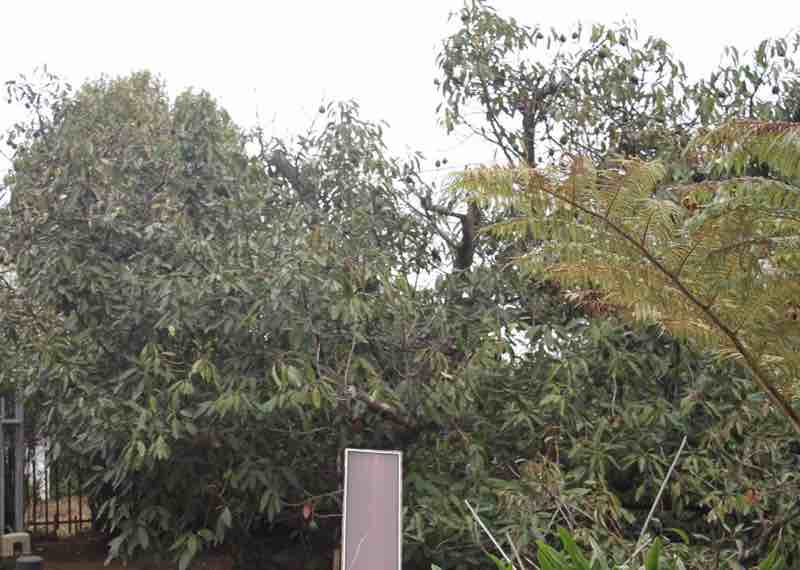
Spot our four decade old Hass. It is easy to reap the fruit; more than 500 per annum. It got hit by a most unusual black frost in 2024; we thought it killed the tree but no it survived. We had to prune it back very hard and it's full of pears again this year.
The cracked solar-panel supplies the DC battery for the gate motor, seen in the bottom left corner.
This page was updated on 8th January, 2025 by Dr Bernard Preston.
Choosing the right variety
It is a bit technical but important if you are planning on growing avocado trees.
Avos have two flowering-kinds and for good pollination, it is best to have one of each. So either plant more than one tree, a type A and a B; or chat to your friends in the neighborhood.
There is a good chance one of them will have an avocado tree; if it is from type A, then you must plant a B.
Also take into consideration how much frost you get. In thirty years, we have had two bad freezes. Many of the branches were killed but our Hass has survived and still supplies us handsomely annually; it is now forty-one.
That means some 20,000 avocados from just one tree; I'll leave you to do the mathematics.
Some varieties are more frost-resistant.
Flowering
Here's the trick. The flowers open twice, the first time to receive pollen from another tree.
And then again the next day to provide pollen for other trees. Let us call these two-openings:
- Flower-opening I: To receive pollen, vital for your fruit.
- Flower-opening II: To provide pollen for other trees; vital for your neighbour's avocado. Then you can both enjoy the benefits.
There is a but; and it is a big one.
Type A flower-opening I (receiving pollen) is in the morning of the first day only, and pollen giving II is in the afternoon of the next day.
Type B flowering opening I is in the afternoon of the first day, and pollen-giving II is the next morning.
Overnight both A and B undergo a sex-change; they are transvestites.
So Type A avos (morning receivers) must have a B (AM pollen providers) in the neighbourhood for good fertilization. There is no point having a tree which gives little fruit.
The tree in the picture above is a Hass in our garden, and I swear it is loaded with more than 500 avos. I usually eat one every day for nine-months of the year.
If you want to grow an avocado tree, and no neighbours have one, then plant a type A like a Hass or Pinkerton; they are less dependent on a cross-pollinator.
Growing avocado trees means that you have the queen of oils, rich in monounsaturated fatty-acids; and olives too, of course.
Growing avocado trees
Type A avocado
The common Type A's are Hass and Pinkerton; I have one of each in our garden. They are the kind that enjoy their sex in the morning and are quite frigid in the afternoons.
They have only got eyes for Type B suitors.
Type B avocado
The most common Type B is the Fuerte. They enjoy their sex in the afternoons, and need an A to provide pollen. Got it? If not, just work through it again, I am a bit slow too and have to read things several times before it clicks; it is called Alzheimer's Light.
We have a Fuerte too in our garden.
Apologies if you find avocado facts boring but, if you want to really enjoy the health benefits of of this wonderful fruit from your own garden, then it is important to grasp the basic science. They are quite unique in their sexual habits.
"In every case where we have studied it, cross-pollination has resulted in increased fruit set. This requires an "A" and a "B" variety growing with their branches overlapping or at least close together."
DR. B.O. BERGH
Planting avocado trees
Choose the right spot.
I have just paced out that 40-year old Hass avocado tree in our garden. It stretches 14 metres in diameter. So, here is the plan.
If you have plenty of space in your garden, plant a Hass and a Fuerte at least 7m apart, and preferably about ten for extra light.
If you have limited space then it is time to have the
neighbours over for drinks. Propose to them that they plant a Hass on their boundary with you, and you set a Fuerte avocado on your side; spin a coin. Then you can both enjoy half
the crop of each tree hanging over the fence.
Avocado growing has one frustration; most varieties with one exception tend to bear very heavily one year, and lightly the next.
If you and your neighbours can make a plan when planting the trees then both families can enjoy the benefits annually; if you are lucky enough that they bear in alternate years. Sometimes it is feast or famine.
Having said that, since using vermi-leachate from our worm farms which promotes flowering, they seem to be bearing nearly every year.
Choose a spot in full sunshine. You will notice that our Hass avocado was being overshadowed by some Cryptomerias. I got a Tree Fella to drop them.
We love trees and think them important for the planet, but you can have too many.
Since we took out the offending Cryptomerias completely, the Hass immediately started to benefit; new shoots abound.
And another update for 2018; this is looking to be a bumper year when all three of our grafted avocados are going to bear together, but the wild one from a pip is still languishing and is over decade old. Not one fruit has set.
We are going to experiment with grafting onto it.
Newsletter
Our newsletter is entitled "create a cyan zone" at your home, preserving both yourself and Mother Earth for future generations; and the family too, of course. We promise not to spam you with daily emails promoting various products. You may get an occasional nudge to buy one of my books.
Here are the back issues.
- Lifestyle and ideal body weight
- What are ultra-processed foods?
- Investing in long-term health
- Diseases from plastic exposure
- Intensive lifestyle management for obesity has limited value
- A world largely devoid of Parkinson's Disease
- The impact of friendly bacteria in the tum on the prevention of cancer
- There's a hole in the bucket
- Everyone is talking about weight loss drugs
- Pull the sweet tooth
- If you suffer from heartburn plant a susu
- Refined maize meal and stunting
- Should agriculture and industry get priority for water and electricity?
- Nature is calling
- Mill your own flour
- Bake your own sourdough bread
- Microplastics from our water
- Alternative types of water storage
- Wear your clothes out
- Comfort foods
- Create a bee-friendly environment
- Go to bed slightly hungry
- Keep bees
- Blue zone folk are religious
- Reduce plastic waste
- Family is important
- What can go in compost?
- Grow broad beans for longevity
- Harvest and store sunshine
- Blue zone exercise
- Harvest and store your rainwater
- Create a cyan zone at your home
Tree planting help
So step one is to go and get your choice and very-strong spade; Two, retire to the boudoir and do your
lower back exercises, top of the agenda even if you do not have a spinal problem.
Otherwise you may soon have. Digging holes 3' square and a metre deep is hard work.
Copy and paste "lower back exercises" into this search engine for more information.
Now swallow several mouthfuls of spring water, grit your teeth, go and do those exercises again.
Take a couple more swallows, no gin allowed, stop and think; and call that strapping lad, your son. I am only joking, gardening gloves, a hat and with plenty of resolve head for the orchard. Two hours' hard labour awaits you.
TREE PLANTING HELP will give some guidance.
The fruit of your labours is over 500 avocados most years for as long as you live.
Avocado growing
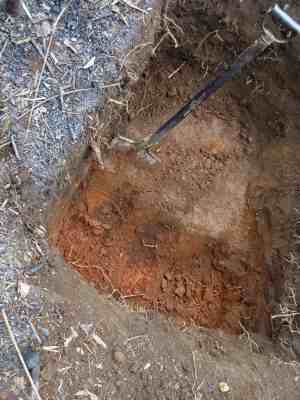
Follow the guidelines at that Tree Planting Help page for more information about what to put into that crater you have just dug.
It is interesting; I am a patient too. I have my back troubles, largely because of a short leg. Several times in the first weeks of "living behind the geraniums" (a Dutch saying for retirement) I had to consult my own DC, happily my daughter with whom I now practise part time, but since then, the more I garden the less lumbago I suffer.
But I very religiously, with great fervour, do those lower back exercises; every morning, without fail.
CROSS POLLINATION
So by and large, when growing avocado trees one has to keep in mind that they are cross-pollinators.
And what does the pollination? Insects, primarily our friendly honeybee that dwell in eleven hives not ten metres away.
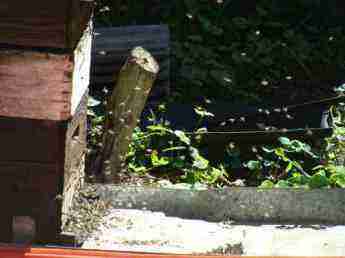
It is no coincidence that we have a good set. Even though that Type A Hass in the top picture is probably fifty metres from our Type B Fuerte (not ideal, too far apart) the fact that we have 50,000 busy little bees in our garden makes the cross-pollination certain. You cannot avoid the science when growing avocado trees.
Colony Collapse is a national disaster in America. No one really understands it yet, but the real value of the bee ironically is not honey; it is pollination. Fortunately avos, unlike almonds, are not utterly dependent on insects.
Here is an aside; the joy of my life is in no small measure because I abhor the couch potato mode of living is flying gliders. Learning to turn off the TV has made so much space for other hobbies; read about one of the most exciting days in my life. Baptiso to immerse ...

Carpentry, beekeeping and writing books like A FAMILY AFFAIR. Meet Jan Jansen, the villain of the peace; and Santie Veenstra and Janet Twycross. Of Peter Thomas who aged 45 suddenly discovers he is the father of four-teenagers.
It is good to have six-books published now.
Have you read my latest trilogy? Only $1.14 each. Hold onto your hat. Find A Family Affair by Bernard Preston at Amazon.
"The art of medicine consists in amusing the patient while nature cures the disease."
Voltaire
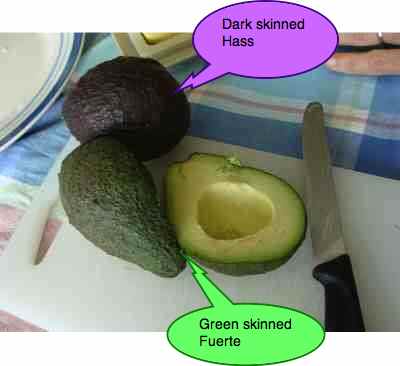
Monounsaturated fatty acid
But nature can't cure if it does not have good nutrition. And, for the bone-setter, healthy nerves means plenty of oleic acid, the monounsaturated fat that coats every fibre. Avocado fat is just one of the virtues of growing these wonderful trees.
These days I am following a lower carb, higher oils menu plan to keep my blood glucose under control. Some proponents of this way of eating recommend very high animal fat ; I can't bring myself to do that, so olives and avocados provide the plant-origin lipids.
Hass
The Hass (a type A) is our favourite when growing avocado trees. It has the creamy texture of the coastal fruit that we can't grow at this altitude (3600') with a nutty flavour.
When the fruit turns black on the tree it's time for me to climb, yes I still do it at 63 twice a week, picking about 20 pears. Then "she who is always right" wraps them in newspaper and they go on a warm sunny-window sill for a week or so.
At 73 now, still taking no drugs, I have decided a fall would not mean a happy landing; I use a ladder and a long pole. Let your food be your medicine was Hippocrates' advice; many doctors have forgtten where their roots lie.
Another big advantage of the Hass is that it is the exception that flowers annually, whereas most avocado hybrids bear only in alternate years. See here one pear about to be picked, and three small ones which will only be ripe next summer.
Hass has fruit every year.
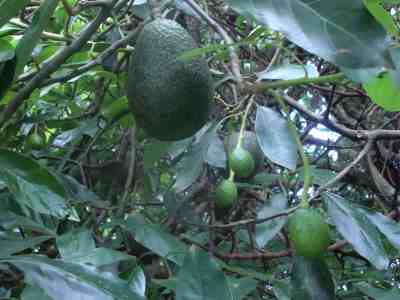
Fuerte avocado tree
The Fuerte (a Type B) also has a smooth texture. What I like is that I can enjoy it on bread without having to use butter.
It's so rich in healthy monounsaturated oils that one really does not need to first butter your bread. We particularly love it in a cucumber and avocado salad.
Growing avocado trees has borne a huge crop this year, but there is not a single fruit set for next season. You have to be patient in the alternate years; pruning a large branch every year makes them bear annually.
Pinkerton avocado tree
I confess I don't know too much about the Pinkerton, a type A. We only planted ours last year, in the hole above, adjacent to the Fuerte, a B, to improve pollination. It survived the coldest winter in sixty-years with no problems. It reputedly also has a great flavour and also is high in those essential fatty acids especially oleic acid.
Starve yourself of fat, the good ones, and the chances of getting those horrible nerve illnesses like Motor Neuron disease increases dramatically, particularly if you are on a high carb diet.
Every nerve is coated in myelin; starve your nerves of fat at your peril.
It's good to look back when gardening and especially when growing
avocado trees; our Pinkerton, now seven years old yielded 150 pears
this year at a retail value of over ten times the price of the tree. That's a lot better than our shares are doing.
We realised that Hass and a Fuerte might not give us year-round fruit annually, hence the third variety. Growing avocado trees, now a Pinkerton is a new experiment for us; a great success, it bore first giving us now nine months of pears from the three kinds.
More about those neurological disease (quite an academically challenging page, but never fear, despite my Alzheimer's Light I managed to write it!) TINGLING IN ARMS AND HANDS AND LEGS...
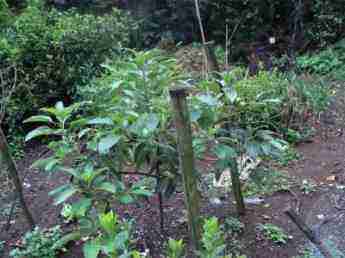
Pinkerton avocado planted one year ago
It is now two and a half years since we planted the Pinkerton. Fancy our delight this spring.
How the years roll by; our Pinkerton is now 8 years old and every season gives us a bounty of fruit, rich and organic with no chemical fertilisers for toxic sprays. Ours bees make sure that every one of those flowers is pollinated.
An avo a day for nine months of the year has not made us fat; in fact they provide the satiety which means we are rarely hungry and have no need to snack between meals.
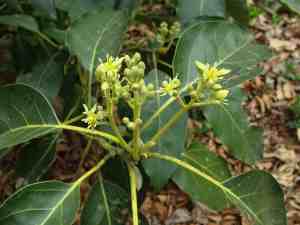
Pinkerton avocado
It is now four years since we planted our Pinkerton avocado and we had seven avos this year, but just look at all the flower on the tree. Next year we're expecting a bumper crop.
The tree is 30 foot tall and only four years old.
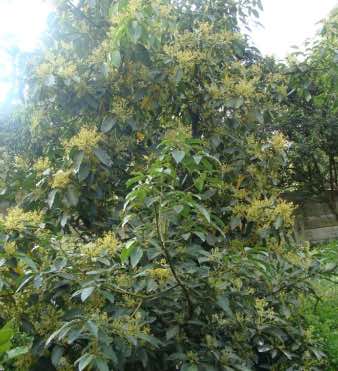
And another update on growing avocado trees; our Pinkerton is now six years old and we are having a feast this year.
One thing I love about growing avocado trees is that they are no fuss plants; they just get on and do what they're supposed to do; produce you a handsome crop of delicious healthy food.
You may need to water them in a prolonged dry spell but if you've been following our rainwater harvesting model then you won't have a problem with that.
Perhaps once a month I do throw a bucket or two of the juice from our rainbow worm farms experiments on them; they are heavy feeders and can use all the extra nutrition you can provide..
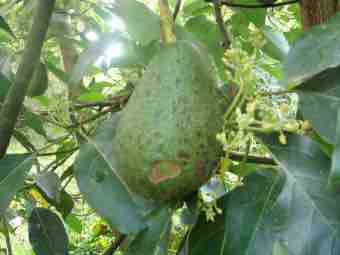
And now at eight years it's producing a prodigious crop; 350 avocados this year; the return on investment far exceeds our best stock market shares.
Root rot avocado trees
You have probably heard of root rot and are wondering about the sense of growing avocado trees. I am no expert on the subject but our experience is that the vermi-leachate has prevented any disease; it is a well known side benefit of keeping your own worm farms.
I pour a bucket of neat leachate around the base of each avocado tree at least once a month.
We also use lime (or gypsum) once every year.
Calories in avocado
Half an avocado, a can of coke and a pint of beer all have about the same number of calories. But the
Calories in avocado unlike coke and beer are obviously very healthy.
It's spring so I've just applied 2 kg of gypsum lime. In November, January and March I'll broadcast 400g of 416 (38) or 619(38) fertilizer, which is recommended by a chiropractic patient who specializes in plant food.
Remember this is the southern hemisphere; in Spring, midsummer and autumn you need to be feeding your trees.
We're still struggling with whether we are totally organic, or inorganic fertilizers have a place in the management of growing avocado trees.
Is avocado rich in calcium?
For those determined to have strong bones avocado is a good for many minerals including calcium and magnesium, both important for skeletal strength. Perhaps even more of value is that the fruit is an excellent source of vitamin K, absolutely necessary for the uptake of these minerals.
Nevertheless the Bulgarian probiotic kefir remains queen of the table.
Sheila's fertilising programme
In the Southern Hemisphere, Sheila's programme is as follows.
- June: 4 cups of lime for an established tree, spread right out to the drip line.
- February and September: 2 cups of 3-1 five organic fertiliser mixed with chicken litter.
Avocado trees are surface feeders. Sheila advocates covering the soil with old logs, sticks and compost to create a soft, soggy bed; perhaps up to 30cm deep.
If the avocados are stringy they need extra lime.
Making honey mead
Making honey mead is an option if you and others have been growing avocado trees; they produce an abundance of pollen and a very dark nectar. Myself, I love all natural honeys, but it's not to the liking of some; if you can get some a little cheaper then making a honey mead would be something interesting, and a little different.
How do you fancy having two dozen quarts of this in the cellar?
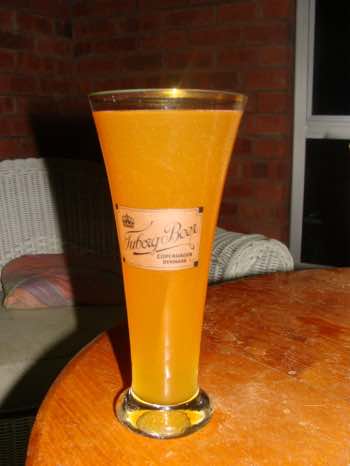
Useful links
Bernard Preston
Bernard Preston is a semi retired DC; growing avocado trees is just one of his many passions.
It's said that at an ancient Greek funeral, the mourners asked only one question; was he passionate? It makes for a full and fun life.
Did you find this page interesting? How about forwarding it to a friendly book or food junkie? Better still, a social media tick would help.
- Bernard Preston homepage
- Avocado
- Growing Avocado Trees
Address:
56 Groenekloof Rd,
Hilton, KZN
South Africa
Website:
https://www.bernard-preston.com